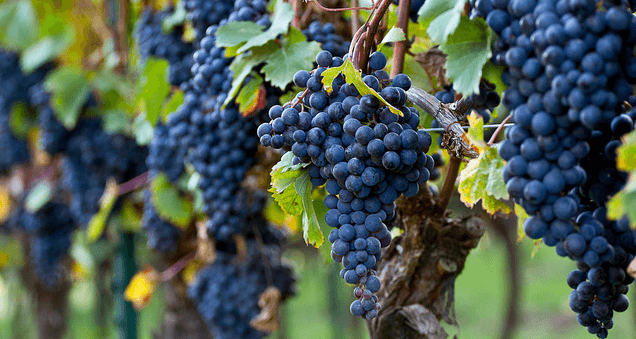Speaking of Grapes…..
Today we’re talking dolcetto. From the Piemonte region of Northern Italy, dolcetto gets no (or little) respect. Always second fiddle to barbera and the big boy nebbiolo (Barolo and Barbaresco). But, dolcetto has been cultivated in the Langhe region (Piemonte) since the 14th century, and ask the locals and they will tell you they love it. It is very popular in the region, with both DOC and DOCG appellations, all made with 100% dolcetto. The grape produces smooth, dry, easy drinking, extremely food friendly wines. Notice the wine produced is dry, which is contrary to the name. Dolcetto, in Italian, means “little sweet one”, but the wine is dry, a little tannic, but not overwhelming, with moderate acidit y. Most popular are the wines made in Alba (Dolcetto d’Alba), on the right side of the river Tanaro. A bonus, this is where Piemonte’s famous hazelnuts are grown also. Grown mostly in cooler sites at altitudes between 500 and 1,300 feet above sea level, the soil is mainly marly limestone. Dolcetto is a fresh, fruity wine, made for drinking between 2-4 years after harvest, but in my opinion, good quality Dolcetto can hold up for a few more years. Dolcetto is naturally low in acidity, but the cooler sites help maintain a good balanced acidity. The color is deep ruby red, with purple nuances since the wine is generally consumed when young. In the nose, you’ll get scents of cherries, strawberries and raspberries, with some blackberries and plum thrown in. Floral aromas of violet and rose are also present. Even though the wine is not aged in wood (with very few exceptions), Dolcetto can be a structured and complex wine. Wood will completely overwhelm the fruity characteristics. So, next time your in a restaurant having just ordered a pizza or pasta dish, don’t fret over the wine selection. Look for a Dolcetto d’Alba. Our selection from Franco Rocca is absolutely fabulous.
y. Most popular are the wines made in Alba (Dolcetto d’Alba), on the right side of the river Tanaro. A bonus, this is where Piemonte’s famous hazelnuts are grown also. Grown mostly in cooler sites at altitudes between 500 and 1,300 feet above sea level, the soil is mainly marly limestone. Dolcetto is a fresh, fruity wine, made for drinking between 2-4 years after harvest, but in my opinion, good quality Dolcetto can hold up for a few more years. Dolcetto is naturally low in acidity, but the cooler sites help maintain a good balanced acidity. The color is deep ruby red, with purple nuances since the wine is generally consumed when young. In the nose, you’ll get scents of cherries, strawberries and raspberries, with some blackberries and plum thrown in. Floral aromas of violet and rose are also present. Even though the wine is not aged in wood (with very few exceptions), Dolcetto can be a structured and complex wine. Wood will completely overwhelm the fruity characteristics. So, next time your in a restaurant having just ordered a pizza or pasta dish, don’t fret over the wine selection. Look for a Dolcetto d’Alba. Our selection from Franco Rocca is absolutely fabulous.